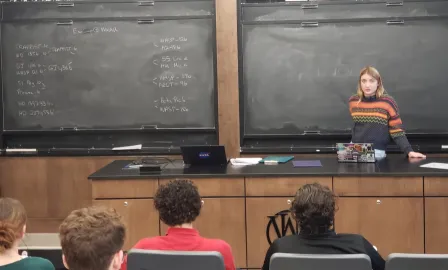Tansu Daylan, assistant professor of physics and fellow of the McDonnell Center for the Space Sciences, joined the physics faculty this fall. His research on the discovery and characterization of exoplanets blends well with the strong space science research conducted by the faculty of the McDonnell Center.
Professor Daylan has been teaching a brand new course this semester called Planets and Life in the Universe (Physics 3330/5330). The class focuses on planetary astrophysics, covering the celestial mechanics of two- and three-body problems, planet formation, evolution, and migration, as well as life as an emergent planetary phenomenon. The course uses the discovery, characterization, and demographics of exoplanets to develop and demonstrate these topics. While much of the course consisted of lectures, the last few classes were of a highly interactive nature. In one of these classes, Daylan planned a special activity he called "ExoCup@WashU."

The activity included a "knockout tournament" between 16 exoplanets, where the exoplanets, championed by the students, competed to win the matches based on their rarity and scientific merit. Before each match during the Round of 16, two students presented the two competing exoplanets. Other students then contributed further remarks, comments, and clarifications in an open discussion. Finally, the class voted to determine which exoplanet won the match. Discussions included information such as the observables (e.g., transits, radial velocity, imaging, microlensing) and physical properties (e.g., radius, mass, equilibrium temperature) of the exoplanet, its historical significance, atmospheric characterization potential, outstanding problems in planetary astrophysics that can be investigated using the exoplanet, any rare properties such as spin-orbit misalignment, habitability prospects, and properties of its host star. The following debate focused on what makes the competing exoplanets unique among the confirmed exoplanets.

Following lengthy discussions with an increasing level of excitement through the quarter- and semi-finals to the final match, the winner of the tournament was WASP-12b. WASP-12b is a close-in exoplanet with a radius roughly two times that of Jupiter. Being very close to its rather hot (F-type) host star, WASP-12, the highest temperature on the dayside of WASP-12b can exceed 3,000 Kelvin. However, one of the most interesting properties of WASP-12b is the measured change in its orbital period, which is apparently decaying at a rate of about 30 milliseconds per year due to tidal interactions with its host star. This implies that the planet will merge with its host star in a few million years.
One of the physics students in the class, Ellie Ertl, said, "I thought it was a really fun class and it was cool to learn about the variety of exoplanets out there." Kenzie Mounir, another undergraduate in the class, comes from the Department of Earth, Environmental, and Planetary Sciences. She said, "Coming from the planetary science side, it really broadened my definition of what a planet can be."
The tournament was an engaging class activity with a high level of student enthusiasm and participation. Perhaps during the next ExoCup@WashU, Professor Daylan will also involve an external panel to participate in the voting on the final round to extend the competitive spirit beyond the classroom!
Header image: WASP-12b (Photo: NASA Visualization Technology Applications and Development)




